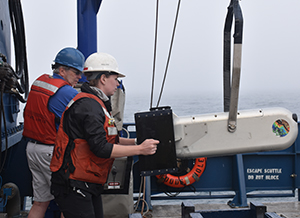The sea is Earth’s most formidable carbon dioxide-storage machine, but mysteries about the interlocking processes of that storage and the myriad organisms involved still abound.
Now, thanks to a series of papers published in the journal Frontiers in Marine Science, researchers at Florida State University and Scripps Institution of Oceanography at UC San Diego are inching toward a clearer understanding of the ocean’s carbon storage, its constituent biological players and the factors that could be limiting its efficiency.
The biological carbon pump is the process by which carbon dioxide produced by photosynthetic algae in the surface ocean is transferred to the seafloor and stored for millennia. In three new studies, FSU Associate Professor of Oceanography and Scripps alumnus Mike Stukel and collaborators found that microscopic zooplankton play critical and sometimes oppositional roles in the transport and sequestration of carbon.
“These organisms contribute to the biological carbon pump by creating carbon-rich fecal pellets that sink rapidly into the ocean,” Stukel said. “However, some zooplankton also feed on sinking particles, thus decreasing the efficiency of the biological carbon pump.”

About 5-12 metric gigatons of carbon are transported yearly by the biological carbon pump — a volume similar to the amount of carbon dioxide produced by humans every year through burning fossil fuels. But hordes of hungry zooplankton hundreds of meters below the surface often consume carbon-rich particles sinking toward the ocean floor, interrupting that transport process.
“This prevents the carbon from being sequestered at deeper depths and ensures that it will be back in the atmosphere sooner,” Stukel said.
Biological oceanographer Mark Ohman of Scripps is a co-author on all three papers and lead investigator of the Scripps-based California Current Ecosystem Long-Term Ecological Research (CCE-LTER) site where the research was carried out. The site is one of 28 around the world established by the National Science Foundation to understand large-scale and long-term ecology.
"This suite of papers illustrates the power of the CCE-LTER approach: assembling a group of scientists with different types of expertise who together can tackle some of the big problems of the day in ocean biogeochemistry," Ohman said.
Most studies of the role of zooplankton in global biogeochemical cycles, Stukel said, have focused chiefly on krill and similarly common groups, with the assumption that their behavior is representative of all zooplankton in the ocean. But one of the studies demonstrates the variety of ways these diminutive organisms can alter, and sometimes impede, the biological carbon pump.
In an investigation of two specific types of zooplankton, phaeodarians and pteropods, Stukel and his team found that these groups of sinking fecal pellet-feeding organisms may influence carbon transport just as much as better-known zooplankton like krill, which dine primarily on floating organic matter nearer to the ocean’s surface.
“Some species have very different characteristics that give them outsized importance in marine biogeochemistry,” he said.
The regular vertical migration of zooplankton from surface to deeper waters is essential to the transport and safe sequestration of carbon in the ocean. Stukel and FSU graduate student Thomas Kelly found that these tireless travelers account for far more carbon transport than previous estimates would suggest.
Stukel and Kelly modeled surface-level algal production rates, biomass estimates, and fish and zooplankton prey requirements. The model showed that the metabolic demands of organisms hundreds of meters below the surface required greater migrator-delivered carbon than expected.
The upshot: Significant carbon transport from vertically migrating zooplankton was more ecologically important than anticipated.
“Most previous estimates of migration-related carbon flux have suggested that migration is only responsible for 5 to 20 percent of downward flux,” Stukel said. “However, our study suggests that previous results may have underestimated the true importance of migration, and that it may actually contribute almost half of total flux in productive coastal regions.”
The research reveals new insights into the micro-scale mechanics of one of the world’s most important carbon transport processes. In addition to highlighting the gatekeeping zooplankton that often halt the sequestration of highly carbonic particles and the historically undervalued role of plankton migrators in the biological carbon pump, the research also makes important suggestions about how to better evaluate carbon flux in variable ocean environments around the world.
Stukel said the best way to achieve a more comprehensive understanding of the biological carbon pump is to develop a deeper appreciation for the impressive array of plankton that keep it pumping.
“Given their diverse roles in the biological carbon pump, it is important for scientists to not only consider how many zooplankton are in a particular region, but also to focus on the diversity and functional roles of these groups,” he said.
Oceanographers Mike Landry and Ralf Goericke of Scripps were also co-authors on one of these papers.
Robert Monroe (adapted from Florida State University)